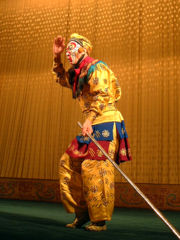| Home | Etymology | History | Performers | Visual | Aural | Repertoire | Film | Opera Houses | |||||
 |
|||||
 |
 The character Sun Wukong at the Beijing opera from Journey to the West[link to wiki] The character Sun Wukong at the Beijing opera from Journey to the West[link to wiki]Beijing opera was born when the "Four Great Anhui Troupes" brought Anhui opera, or what is now called Huiju, to Beijing in 1790, for the birthday of the Qianlong Emperor. Beijing opera was originally staged for the court and came into the public later. In 1828, some famous Hubei troupes came to Beijing. They often jointly performed in the stage with Anhui troupes. The combination gradually formed Beijing opera's main melodies. Beijing opera is generally regarded as having fully formed by 1845. Although it is called Beijing opera (Beijing theatre style), its origins are in the southern Anhui and eastern Hubei, which share the same dialect of Xiajiang Mandarin (Lower Yangtze Mandarin). Beijing opera's two main melodies; Xipi and Erhuang originated from Shanxi but developed in Anhui and Hubei. Xipi literally means 'Western Skin Puppet Show', referring to the puppet show that is originated from Shaanxi province. Puppet Shows in China always involve singing. Much dialogue is also carried out in an archaic form of Standard Mandarin, in which Zhongyuan Guanhua (Zhongyuan Mandarin) dialects in Henan and Shaanxi are closest. This form of standard Mandarin is recorded in the book Zhongyuan Yinyun. It also absorbed music and arias from other operas and local Zhili musical art forms. Some scholars believe that the Xipi musical form was derived from the historic Qinqiang, while many conventions of staging, performance elements, and aesthetic principles were retained from Kunqu, the form that preceded it as court art. Thus, Beijing opera is not actually a monolithic form, but rather a coalescence of many older forms. However, the new form also introduced its own innovations. The vocal requirements for all of the major roles were greatly reduced for Beijing opera. The Chou, in particular, rarely has a singing part in Beijing opera, unlike the equivalent role in Kunqu style. The melodies that accompany each play were also simplified, and are played with different traditional instruments than in earlier forms. Perhaps most noticeably, true acrobatic elements were introduced with Beijing opera.[13] The form grew in popularity throughout the 19th century. The Anhui troupes reached their peak of excellence in the middle of the century, and were invited to perform in the court of the Taiping Heavenly Kingdom that had been established during the Taiping Rebellion. Beginning in 1884, the Empress Dowager Cixi became a regular patron of Beijing opera, cementing its status over earlier forms like Kunqu. The popularity of Beijing opera has been attributed to the simplicity of the form, with only a few voices and singing patterns. This allowed anyone to sing the arias themselves. Beijing opera was initially an exclusively male pursuit. The Qianlong Emperor had banned all female performers in Beijing in 1772. The appearance of women on the stage began unofficially during the 1870s. Female performers began to impersonate male roles and declared equality with men. They were given a venue for their talents when Li Maoer, himself a former Beijing opera performer, founded the first female Beijing opera troupe in Shanghai. By 1894, the first commercial venue showcasing female performance troupes appeared in Shanghai. This encouraged other female troupes to form, which gradually increased in popularity. As a result, theatre artist Yu Zhenting petitioned for the lifting of the ban after the founding of the Republic of China in 1911. This was accepted, and the ban was lifted in 1912, although male Dan continued to be popular after this period. |
||||
 |
|||||
 |
|||||
| Copyright RUIWEI Credit Page | |||||